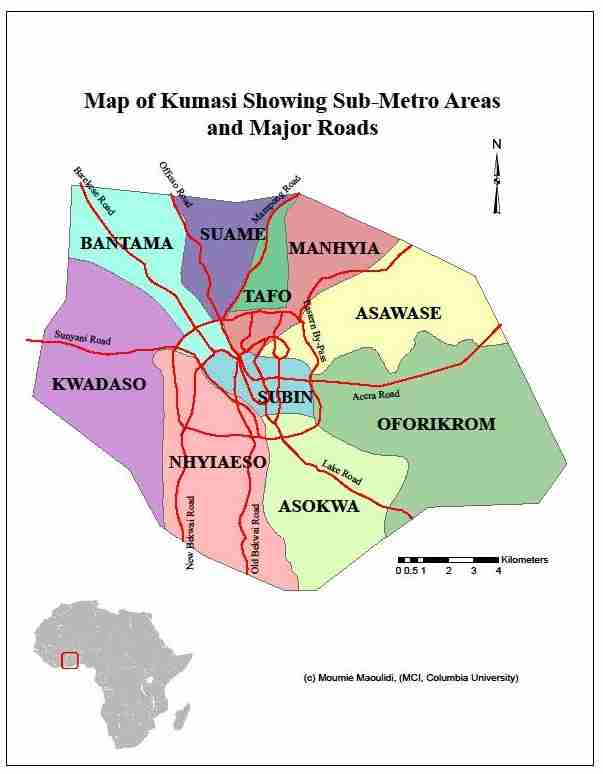What is the population of Kumasi? Kumasi is the second-most populous city in Ghana with the current metro area population of Kumasi in 2022 being 3,630,000, a 4.01% increase from 2021’s 3,490,000.

Kumasi is the second-largest city in Ghana, after the capital Accra. The city functions as the administrative, commercial, industrial, and cultural center of the Ashanti region. Kumasi and the Ashanti Region are regarded as the cultural center of Ghana.
Increasing urban migration into and around the city in Kumasi due to the expansion of industries and commercial activities has resulted in the population of the city increasing dramatically over the last 40 years.
1970’s census reported 346,000 inhabitants, with over one million after 2000 and more than two million in 2013.
This article provides an insight into the demographic makeup of the city of Kumasi in Ghana. The population is primarily lower, with a small middle-class group. Inasmuch as the majority is lower-class, there are wealthy businesspeople in. and from the metropolis.
Table of Contents
Where is Kumasi?
Kumasi is the capital of the Ashanti Region of Ghana. Ashanti Region is located between longitude 0.15°W and 2.25°W, and latitude 5.50°N and 7.46°N.
The region lies mostly within the tropical rainforest zone. The northern part of the region is in the ecological zone of woodland savanna.
Breakdown of Population of Kumasi
The main Kumasi metropolitan area covers an area of 254 square kilometers and encompasses 5 sub-metropolitan and 5 Municipal areas— Manhyia North, Manhyia South, Bantama, Nhyiaeso and Subin has a population of 443,981. 213,662 males and 230,319 females.
The other 5 municipal assemblies are Oforikrom, Asokwa, Kwadaso, Suame, Old Tafo, and Asokore Mampong consisting of a total of 935,354 with 457,101 males and 478,253 females.
Kumasi metropolis in totality has 1,379,335 inhabitants of which 670,763 males and 708,572 females in this area.
The Greater Kumasi area consists of the Kumasi metropolis plus 8 other surrounding municipal assemblies. These assemblies comprise Atwima Kwanwoma, Kwabre East, Afigya Kwabre North, Afigya Kwabre South, Atwima Nwabiagya North, Atwima Nwabiagya South, Bosomtwi and Ejisu Juaben Municipality. They also come in with a population of 1,502,478 of which there are 732,597 males and 769,521 females.
Kumasi Metropolitan Area
| Sub-metros & Municipalities | Males | Females | Total |
| Nhyiaeso | 56,981 | 57,963 | 114,944 |
| Subin | 38,718 | 37,748 | 76,466 |
| Manhyia South | 17,406 | 20,732 | 38,138 |
| Manhyia North | 43,174 | 48,719 | 91,893 |
| Bantama | 57,383 | 65,157 | 122,540 |
| Oforikrom Municipal | 107,426 | 105,700 | 213,126 |
| Asokwa Municipal | 61,000 | 64,642 | 125,642 |
| Kwadaso Municipal | 75,205 | 79,321 | 154,526 |
| Suame Municipal | 64,878 | 71,412 | 136,290 |
| Old Tafo Municipal | 55,086 | 59,282 | 114,368 |
| Asokore Mampong Municipal | 93,506 | 97,896 | 191,402 |
Kumasi metropolis is the most populous district in the Ashanti region. The city covers —Asawasi, Asokwa, Bantama, Kwadaso, Manhyia, Nhyiaeso, Oforikrom, Suame, Subin, and Tafo. It is strategically located in south-central Ghana and all major roads converge at the city center.
Greater Kumasi
Greater Kumasi is a metropolitan area that includes the Kumasi metropolis, five sub-metros: Kpando, Hohoe, Ahenkro, Sefwi Wiawso, and Techiman. As well as 5 municipal assemblies:
The population of Greater Kumasi was estimated to be 1,379,335 people as of the 2021 census data.
Kumasi Metropolitan Area
| Metropolis and Municipalities | Males | Females | Total |
| Kumasi Metropolis | 670,763 | 708,572 | 1,379,335 |
| Atwima Kwanwoma | 114,123 | 120,723 | 234,846 |
| Kwabre East | 143,684 | 153,130 | 296,814 |
| Afigya Kwabre South | 115,067 | 119,600 | 234,667 |
| Afigya Kwabre North | 36,608 | 36,722 | 73,330 |
| Atwima Nwabiagya North | 76,877 | 78,148 | 155,025 |
| Atwima Nwabiagya South Municipal | 78,334 | 83,559 | 161,893 |
| Ejisu Juaben Municipality | 87,836 | 92,887 | 180,723 |
| Bosomtwi | 80,428 | 84,752 | 165,180 |
Locational Characteristics of Greater Kumasi Sub-Region
3.1.1 Locational Characteristics of Greater Kumasi within Western African Region. Greater Kumasi Sub-Region is located between longitude 1°15’W and 2°00’W, and latitude 6°15”N and 7°10’N. The whole area lies in the Tropical Rain Forest Zone, approximately 250km inland from the coast.
Greater Kumasi Sub-Region within Western Africa
The population of the major cities in the neighbouring landlocked countries gives Ghana an advantage as a coastal country.
As for Greater Kumasi Sub-Region, Kumasi being the intersection point of the major roads connecting Ouagadougou, the capital city of Burkina Faso with the coastal cities such as Accra and Takoradi, Kumasi has been attracting people as the centre of commerce with one of the largest open markets in Western Africa.
From Ouagadougou, Trans-Sahelian Highway connects the major cities in Mali, Burkina Faso and Niger.
Greater Kumasi lies on the southern side of Manpong-Gambaga scarp, which splits the region into two different environments.
The city of Kumasi is at the intersection of routes that connects the north and south of the country. All cities in Ghana can be reached from Kumasi within one day by road including the major regional capital cities.
Despite the fact that Kumasi does not lie in the coastal area, the road network has contributed in many ways to attract people to Kumasi.
Urbanization
The urbanization rates of the Ashanti Region increased from 25 percent in 1960 to 51 percent in 2000 and a further 15% in 2021. The urbanization rate of the Ashanti Region is the second highest next to the Greater Accra Region. The average annual growth rate from 1984 to 2000 (6.3%) was particularly high, exceeding the national average (4.6%).
| Male | Female | Total | |
| Ashanti | 2,679,914 | 2,760,549 | 5,440,463 |
| Urban | 1,627,608 | 1,726,242 | 3,353,850 |
| Rural | 1,052,306 | 1,034,307 | 2,086,613 |
History of Kumasi’s and how it became a major population center
Kumasi, Ghana’s second-largest metropolitan area, was once the capital of the Asante Empire. Founded in the 1650s by Osei Tutu I, it became an important center for trade because of its central location and favorable climate. It soon became the country’s largest population center with 1 million residents in the early 2000s.
History of Kumasi
Kumasi has a rich history that dates back to at least the 16th century.
Not only Ashanti people living in Kumasi today. Of course, many of them are Asantes – descendants of the people who lived here centuries ago, but the city is now a metropolitan area with people from diverse backgrounds.
The majority of the population in Kumasi are made up of people of the Akan ethnicity, followed by northerners and other tribes in Ghana. Kumasi has a population density of around 4,858 inhabitants per square kilometer.
The density of Kumasi is very high compared to other cities in Ghana, and in West Africa. The average per capita income of Kumasi is $1,929, which is higher than the national average of $1,541. The population of Kumasi is increasing rapidly, with a population increase of about 6,390 people per year.
Kumasi’s economy is growing at a rapid pace.
The gross domestic product of Kumasi has increased by close to 20%, from $824.7 million in 2010 to about $972.4 million in 2012. The economic growth of Kumasi can be attributed to the growth of the manufacturing sector, telecommunications, as well as the increasing number of local and regional businesses in the city.
The average life expectancy for a male in Kumasi is 69 years old, and the average life expectancy for a female in Kumasi is 70 years old. Kumasi has a relatively younger population which shows that there are many opportunities available for young men and women who want to start their own business or work in an office environment.
Map of Kumasi
Kumasi is the capital of the Ashanti Region in Ghana. The city has a population of 3,490,000 people according to the 2021 population census.
Located about halfway between Accra and Cape Coast on the north coastal plain near the Gulf of Guinea.
The Climate in Kumasi
The climate in Kumasi, Ghana is very hot and humid throughout the year with the exception of one or two months that see some precipitation. March is the hottest month of the year.
The rainy season starts from anywhere from April through June to October depending on various reasons. August is the coolest month of the year.
however, the weather over the last decade makes nonsense of any whether forecast o prediction. Crazy weather conditions can crop in anytime in recent times.
The average high temperature is around 95°F (35°C) and the average low temperature at night is around 75°F (28°C). This means that the temperatures remain to be tropical during the day and it doesn’t cool down much at night. The humidity level can also reach up to 97%, which makes for a muggy environment in recent years when there are no rains.
Transportation: How people get to and from Kumasi, whether by plane, train, or automobile
There are different ways people get to and from Kumasi depending on their location. For example, if you are on a business trip then you will most likely take an airplane to travel to Kumasi. If you are not in a hurry then you may have to drive or take the bus to the city. However, if you live near Kumasi then you would probably use public transportation such as trotro’s, buses, or taxis to go to your destination.
Transportation Network
Ashanti Region is served by five national roads and two inter-regional roads which make the Kumasi Metropolitan area a pivotal point of national and inter-regional transportation, and 13 regional roads connect to the Kumasi Metropolitan area.
The railroad construction in Ghana started at the end of the 19th century. The west line was opened for traffic to Kumasi in 1903, the east line was opened for traffic to Kumasi in 1923, and transportation of passengers and cargos was carried out. A railroad network was built in the southern part of Ghana, which had higher economic production and a large population. However, the Eastern Line stopped its long-distance operation in 2002 and the Western Line in 2007 because of the frequent occurrence of accidents.
Passenger and Cargo Traffic Patterns
Since the railroad operation has been suspended for many years, passenger transport is dependent on private cars, taxis, trotros, and buses, and cargo transport is dependent on trucks in Ashanti Region. Therefore, networks of trotros and buses are well developed connecting Kumasi’s downtown area with Kumasi’s suburbs and major cities/towns inside and outside of the region.
Long-distance routes of trotro start from the bus terminals of Asafo Market and Kejetia, for Bogoso, Tarkwa and Takoradi of the Western Region, Mankessim and Cape Coast of the Central Region, Koforidua of the Eastern Region, Accra and Tema of the Greater Accra Region, Buipe, Yapei and Tamale of the Northern Region, etc. Additionally, middle-distance routes in the region arrive and depart at the bus terminals of Kejetia and Dunkirk, and short-distance routes around Kumasi start from Kejetia and travel towards many destinations.
Transportation by Air or Buses
People can now get to and from Kumasi, whether by plane, bus, or car.
There is the main international airport in Accra, Kotoka International Airport. however, plans ad renovations are ongoing to upgrade the Kumasi airport into an international one to serve the city; and the northern part of Ghana. This development will help to get regular flights connecting Kumasi to other major cities within Ghana, West Africa and the world at large.
There are buses everywhere in Kumasi. Situated in the central part of Ghana, Kumasi is the best place to connect to other parts of Ghana by bus. The most popular routes include: Accra-Kumasi, Tamale – Kumbungu/Accra, Takoradi – Kumasi, Cape Coast – Kumasi, Sekondi – Kumasi, Sunyani – Kumasi, Ho – Kumasi, Sefwi Wiawso, etc…
Kumasi is also connected by most of the major roads in Ghana making it a great destination for travel with your own car. There are many hotels available all over Kumasi including some very luxurious ones. Most people prefer staying near the city centre where there are more options for restaurants, bars, shopping malls, cinemas, banks, ATMs, internet cafes, etc.
Having the comfort of driving your own car to and from Kumasi cannot be underrated, it is one to consider if you have time on hand as well as money to spare.
Demographics: A breakdown of who lives in Kumasi based on race, religion, sex, etc.
The population of Kumasi is not necessarily wealthy and upper-class. In fact, Ghana is a middle-class, low-class country. However, the wave is turning gradually and urbanization crippling in with a small middle-class group.
The majority of the population is lower-class, but they are not suffering from extreme poverty.
The city has some slums that house poor people, however, these areas do not seem to affect the overall quality of life for most residents. There are also some high-rise apartments built by government agencies and private companies.
These buildings have been constructed to accommodate workers who work at nearby industries such as textile factories or cement plants. The housing stock varies greatly depending on where you live within the city. Some neighborhoods may be very well maintained while others can look like shantytowns.
Concluding thoughts…
In conclusion, the population of Kumasi is growing at a rapid pace due to the high influx of migrants from rural areas and international immigrants. In order to accommodate this influx, it would be necessary for the government to invest in infrastructures such as roads, water systems, and sewage systems.
Also Read:
Kumasi City Mall: Everything You Need to Know!
The Complete Travel Guide To Kumasi. What to Expect!
Time in Kumasi: What time is it in Kumasi, Ghana? [MUST READ]
Where is Kumasi Ghana: Explore The Historic Landscape Of the Garden City



